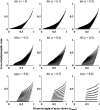Effects of female preference intensity on the permissiveness of sexual trait polymorphisms
- PMID: 29760892
- PMCID: PMC5938471
- DOI: 10.1002/ece3.3957
Effects of female preference intensity on the permissiveness of sexual trait polymorphisms
Abstract
Recent developments in sexual selection theory suggest that on their own, mate preferences can promote the maintenance of sexual trait diversity. However, how mate preferences constrain the permissiveness of sexual trait diversity in different environmental regimes remains an open question. Here, we examine how a range of mate choice parameters affect the permissiveness of sexual trait polymorphism under several selection regimes. We use the null model of sexual selection and show that environments with strong assortative mating significantly increase the permissiveness of sexual trait polymorphism. We show that for a given change in mate choice parameters, the permissiveness of polymorphism changes more in environments with strong natural selection on sexual traits than in environments with weak selection. Sets of nearly stable polymorphic populations with weak assortative mating are more likely to show accidental divergence in sexual traits than sets of populations with strong assortative mating. The permissiveness of sexual trait polymorphism critically depends upon particular combinations of natural selection and mate choice parameters.
Keywords: assortative mating; fisher process; null model; polymorphism permissiveness; sexual selection.
Figures


Similar articles
-
Joint effects of female preference intensity and frequency-dependent predation on the polymorphism maintenance in aposematic sexual traits.Ecol Evol. 2022 Oct 11;12(10):e9356. doi: 10.1002/ece3.9356. eCollection 2022 Oct. Ecol Evol. 2022. PMID: 36248673 Free PMC article.
-
Sexual selection and assortative mating: an experimental test.J Evol Biol. 2016 Jul;29(7):1307-16. doi: 10.1111/jeb.12855. Epub 2016 Mar 25. J Evol Biol. 2016. PMID: 26970522
-
The effects of sexual selection on trait divergence in a peripheral population with gene flow.Evolution. 2015 Oct;69(10):2648-61. doi: 10.1111/evo.12762. Epub 2015 Sep 16. Evolution. 2015. PMID: 26332694
-
Temperature coupling of mate attraction signals and female mate preferences in four populations of Enchenopa treehopper (Hemiptera: Membracidae).J Evol Biol. 2019 Oct;32(10):1046-1056. doi: 10.1111/jeb.13506. Epub 2019 Jul 30. J Evol Biol. 2019. PMID: 31278803 Review.
-
Geography, assortative mating, and the effects of sexual selection on speciation with gene flow.Evol Appl. 2015 Aug 26;9(1):91-102. doi: 10.1111/eva.12296. eCollection 2016 Jan. Evol Appl. 2015. PMID: 27087841 Free PMC article. Review.
Cited by
-
Strong spatial population structure shapes the temporal coevolutionary dynamics of costly female preference and male display.Evolution. 2022 Mar;76(3):636-648. doi: 10.1111/evo.14426. Epub 2022 Jan 19. Evolution. 2022. PMID: 34964487 Free PMC article.
-
Joint effects of female preference intensity and frequency-dependent predation on the polymorphism maintenance in aposematic sexual traits.Ecol Evol. 2022 Oct 11;12(10):e9356. doi: 10.1002/ece3.9356. eCollection 2022 Oct. Ecol Evol. 2022. PMID: 36248673 Free PMC article.
-
Male and female contributions to diversity among birdwing butterfly images.Commun Biol. 2024 Jul 1;7(1):774. doi: 10.1038/s42003-024-06376-2. Commun Biol. 2024. PMID: 38951581 Free PMC article.
References
-
- Beisner, B. E. , Haydon, D. T. , & Cuddington, K. (2003). Alternative stable states in ecology. Frontiers in Ecology and the Environment, 1, 376–382. https://doi.org/10.1890/1540-9295(2003)001[0376:ASSIE]2.0.CO;2 - DOI
-
- Brooks, R. (2002). Variation in female mate choice within guppy populations: Population divergence, multiple ornaments and the maintenance of polymorphism. Genetica, 116, 343–358. https://doi.org/10.1023/A:1021228308636 - DOI - PubMed
-
- Brooks, R. , & Endler, J. A. (2001). Direct and indirect sexual selection and quantitative genetics of male traits in guppies (Poecilia reticulata). Evolution, 55, 1002–1015. https://doi.org/10.1554/0014-3820(2001)055[1002:DAISSA]2.0.CO;2 - DOI - PubMed
-
- Bulmer, M. (1989). Structural instability of models of sexual selection. Theoretical population biology, 35, 195–206. https://doi.org/10.1016/0040-5809(89)90017-8 - DOI - PubMed
-
- Chunco, A. J. , McKinnon, J. S. , & Servedio, M. R. (2007). Microhabitat variation and sexual selection can maintain male color polymorphisms. Evolution, 61, 2504–2515. https://doi.org/10.1111/j.1558-5646.2007.00213.x - DOI - PubMed
LinkOut - more resources
Full Text Sources
Other Literature Sources

